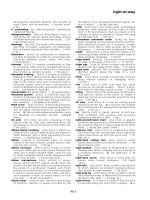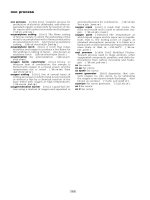Handbook of Lubrication Episode 2 Part 7 pptx
Bạn đang xem bản rút gọn của tài liệu. Xem và tải ngay bản đầy đủ của tài liệu tại đây (553.96 KB, 17 trang )
Strength
Cyclic contract stresses may vary from 700 to 2800 MPa (100,000 to over 400,000 psi)
in operation and shock loads may range to 4100 MPa (600,000 psi). Fatigue life is inversely
proportional to the 7th to 10th power of the stress under the most heavily loaded rolling
element. Maximum hardnesses are limited by material sensitivity to cracking and metal-
lurgical stability.
Due to the high-contact stress and subsurface shear stress in rolling element bearings,
surface or near-surface elements must be hardened to a minimum of Rockwell C59. To
support the high-subsurface stresses, the supporting core must be of equal hardness or provide
a hardness gradient that insures structural integrity and fatigue life. Strength and hardness
Volume II503
Table 3
RADIALINTERNALCLEARANCE SELF-ALIGNING ROLLER
BEARINGS, METRIC
Tolerance Limits in 0.0001 In.
Note: Tolerance limits for radial internal clearance in self-aligning roller bearings under no
load. This table applies to bearings conforming to the Basic Plan for Boundary
Dimensions of Metric Radial Bearings, AFBMASiandards, Section 2, Table 1.
a
These symbols relate to the AFBMA Standard Section 5 — identification code.
Copyright © 1983 CRC Press LLC
at operating temperature must be considered since commercial bearing materials are required
to operate at 120°C (250°F) with no derating. At higher temperatures, either increased scatter
in early life or reduced average life must be anticipated. Over 175°C (350°F), materials with
high hot-hardness such as the tool steels are required. Table 4 gives commonly used materials
and their temperature limits.
Where static loads are encountered with bearings not rotating, resistance to plastic in-
dentation becomes important. Static capacities are normally chosen to insure no significant
indentation of the raceways. Some bearings, however, can operate subsequently at lower
loads with slight brinelling with no significant effect on system behavior. When carburized
materials with higher core strength are chosen, these static loads should not exceed the crush
strength of the case and it is advisable to determine these limits by laboratory tests.
Fatigue Resistance
Whereas high carbon chromium bearing alloys were once felt essential to adequate fatigue
life, most materials, properly hardened, and with sufficient core strength to support the shear
stress can insure satisfactory life and life dispersion. Fatigue resistance is also a function of
residual stresses remaining after bearing manufacture. Tensile stresses are to be avoided and
in many cases it is advisable to specially process inner rings in a manner to limit these. In
those applications where abrasion, overheating, lubricant depletion, or abusive assembly
stresses in the inner and outer rings are anticipated, provisions must be made to limit the
stress or else reduced bearing life may be anticipated.
504 CRC Handbook of Lubrication
Table 4
APPROXIMATE TEMPERATURE LIMITS
FOR ROLLING BEARING STEELS
b
a
Has been used successfully at 205°C (400°F) when heat
stabilized, with increased internal clearance in bearing,
and very light load.
b
Based on hot-hardness and temper resistance.
Copyright © 1983 CRC Press LLC
Wear
Fortunately, the more commonplace materials used today, namely 52100, TBS9 (Timken
®
),
and the various carburizing steels have excellent resistance to wear under normal operating
conditions with full film lubrication. Any abrasion is detrimental due to the damaging effects
of increased osculation between the rolling elements and inner rings. Wear between the
rolling elements and retainer can be controlled for the most part by proper selection of the
retainer materials and by optimizing the geometry of the contact of the rolling element and
retainer.
Dimensional Stability
In case of thru-hardening steels, operating temperatures must be limited to 120°C (250°F)
or provisions made to accommodate potential distortion/growth of the inner rings. For higher
operating temperatures, parts must be “stabilized” by additional heat treatment or tempering
and/or deep freezing to insure transformation of all retained austenite. In the case of car-
burized parts where the volume of retained austenite is small, transformation is not significant.
In the transformation of retained austenite in the finished part made of conventional thru-
hardening materials, shrinking is encountered after relatively few hours of operation. This
is followed by growth during extended operation or exposure to higher temperature. AFBMA
standards are available as a guide in selection of parts for stability.
For corrosive conditions, it is advisable to consider means for protecting the bearing other
than resorting to exotic materials. Some stainless steels are used occasionally in rolling
element bearing for specialized applications and must be chosen with care. Fatigue data and
relative life of these materials are not well substantiated in many cases.
Retainer Materials
Commercial bearings in past years generally used a leaded bronze or an aluminum bronze
for retainers. More recently, ferrous materials have been used either as strip steel or castings.
Recently the use of polymeric retainers has developed, primarily heat-stabilized nylon 6-6
both with and without glass reinforcement. In ball bearings polymers are of great value
since they are better able to endure the adverse operating conditions induced by moment
loads.
For high-temperature applications, particularly with marginal lubrication, coated retainers
generally made of various ferrous materials have been selected. The aerospace industry has
utilized an iron-silicon bronze, both plated and unplated, for adequate strength at higher
temperatures. Oiling systems in early gas turbine engines could supply no additional lubricant
to a bearing for long periods at startup. Under these conditions, break-in or sacrificial films
were essential and the bronze retainers used were generally silver plated or silver plated
with a lead-tin overlay.
Nodular-graphite iron retainers have good wear properties when properly prepared and
resist some gases which may be found in lubricants. In ammonia compressors, they endure
the environment detrimental to most normally used bronzes. Nylon polymers are sensitive
to materials with free phosphorus on the surface, to a limited number of diluents and solvents,
and to some lubricants.
Breakdown products must be anticipated from operating lubricants and their additive
packages at high temperatures. Material selection must anticipate attack from EP additives
at high temperature. Many boundary lubricants are particularly detrimental. Moisture is
doubly harmful in that it can aid breakdown products to become corrosive and attack bearing
surfaces.
ROLLING BEARING THEORY
Contact of Elastic Bodies
Two basic theoretical types of contact occur between elastic solids, namely point contact
Volume II 505
Copyright © 1983 CRC Press LLC
and line contact. Point contact refers to the conjunction of two elastic bodies such that the
initial contact, under no load, is a single point. As load is applied, the bodies deform
elastically and the contact spreads out into a finite area of elliptical shape. Assuming that
the pressure is entirely normal to the contact surface (i.e., there are no tangential or frictional
forces) the contact pressure assumes a semiellipsoidal distribution as shown in Figure 6.
As defined schematically in Figure 7, typical osculation values for ball bearings are 51
to 52% for the inner race and 52 to 53% for the outer race. For spherical roller bearings,
osculation is normally given as the ratio of the radius of curvature of the rolling element to
the radius of curvature of the ring raceway. Typical values range from 94 to 99%. Osculation
clearance is the clearance at the end of the effective length of contact between a roller and
a raceway.
Theoretical line contact is that which occurs between two cylinders with parallel axes, or
a cylinder and a flat plate of infinite length in the cylinder axial direction. Under load, the
bodies deform elastically and the contact area becomes a rectangle. The distribution of
pressure over this contact surface is uniform in the axial direction and elliptical in the
direction perpendicular to the axis, as illustrated in Figure 6. Since actual bearing contacts
are not infinitely long, true line contact is only approached under certain conditions in real
bearings.
RollerCrowning
If a cylinder of some finite length is loaded against another cylinder or flat, a stress
concentration develops at the end of contact due to the discontinuity. For lightly loaded
cylindrical or tapered roller bearings, this stress concentration is not serious. With high load
or with misalignment, however, it can drastically reduce bearing life. Therefore most (but
by no means all) cylindrical and tapered roller bearings utilize crowned rollers such as
illustrated in Figure 8. The full crown is a circular arc that results in a contact ellipse with
a length to width ratio on the order of 50. To overcome the rather short length of contact
with a full crown under light load, the partial crown provides a straight length of about 50
to 60% of the roller length, with only the ends relieved. This type of crown has two
disadvantages: (1) stress concentrations under heavy loads at the junction between the crown
and the straight length, and (2) less tolerance of misalignment than the full crown. At least
one manufacturer provides a modified full crown: flatter in the center of the roller with
increasing curvature toward the ends. Typical values of roller crown radius range from 1 to
506CRC Handbook of Lubrication
FIGURE 6. Stress distributions over elliptical “point” contact area and rectangular “line” contact (no end
effects).
Copyright © 1983 CRC Press LLC
25 m (50 to 1000 in.). Osculation clearances are normally in the range of 5 to 50 μm (0.0002
to 0.002 in.).
Contact Stresses
The maximum principle stress, which is often used as a measure of load severity, is the
compressive stress normal to the contacting surface at the center of the contact ellipse.
Normally, however, one of the sheer stresses at some depth below the contact surface is
decisive with regard to the load-carrying ability of the contact. Typically, maximum com-
pressive stress for the most heavily loaded rolling element for normally loaded rolling bearings
is in the range of 700 to 1400 MPa (100,000 to 200,000 psi), with roller bearings tending
toward the lower end of that range, and ball bearings the higher. Ahigh stress in a very
heavily loaded rolling bearing would be 2500 MPa (360,000 psi). In a nonrotating bearing,
stresses up to 4000 MPa (580,000 psi) and higher sometimes can be tolerated without
significant impairment of subsequent operation. Reference 3 gives the most general method
of calculating stresses in a concentrated contact, while References 4 to 8 give procedures
particularly adapted to rolling element bearings. Hartnett
7
provides a means of estimating
potential stress concentrations with crowned rollers. Hamrock
8
has developed a very simple
method which may be carried out on a hand calculator.
Nomenclature
Definitions required for discussion of loads and motions within rolling bearings are listed
below and are illustrated in Figures 9 to 12 for ball, cylindrical roller, spherical roller, and
tapered roller bearings.
508 CRC Handbook of Lubrication
FIGURE 9. Radial ball bearing nonmenclature.
Copyright © 1983 CRC Press LLC
f
i
, F
o
= Inner and outer race osculations for ball bearing (see Figure 7)
i = Number of rows of rolling elements
K = Coefficient in the load-deflection equation; depends upon material,
elastic properties, and osculation
1 = Roller length
l
eff
= Effective length of contact between roller and ring raceway
N = Number of stress cycles
N
1
, N
o
, = Rotational speed of inner ring, outer ring, and cage
N
c
N
r
= Rolling element rotational speed about its own axis (i.e., relative to
the cage)
Q = Rolling element load
S = Probability of survival
t = Exponent in the load-deflection equation; depends upon osculation
V = Stressed volume
y = Dcos α/d
m
Z = Number of rolling elements per row
z
o
= Depth of maximum orthogonal shear stress
α = Contact angle (also 1/2 included cup angle for tapered roller
bearings)
β = 1/2 Included cone angle (tapered roller bearings)
γ = 1/2 Included roller centerline angle (taper roller bearings)
δ = Deflection
λ = Life reduction factor for stress concentrations
v = 1/2 Included roller angle (tapered roller bearings)
τ
°
= Maximum orthogonal shear stress
Volume II 509
FIGURE 10. Cylindrical roller bearing nomenclature.
Copyright © 1983 CRC Press LLC
Contact Deformations and Load Distribution
To determine the magnitude of the contact stresses occurring in a rolling bearing, one
must first determine the magnitude of the load on each rolling element. Figure 13 shows a
free-body diagram of a radially loaded bearing. The equations of static equilibrium are not
sufficient to determine the distribution of load among the rolling elements; load-deflection
relationships at the rolling element-raceway contacts are also required. In addition, it is
necessary to assume that the ring is round before loading and remains round after loading,
and the only deflections are those at the Hertzian contacts. In general, load-deflection
relationship for a Hertzian contact can be expressed by:
Q = Kδ
t
(1)
Typical values for coefficient K and exponent t are given in Table 5. They do not vary
greatly for rolling element contacts for bearings with the usual range of power transmission
applications, say 25- to 300-mm (1- to 12-in.) shaft size. Heavily loaded ball bearings,
where the contact ellipse is of significant size in relation to the ball diameter, may be
somewhat stiffer than indicated by the foregoing relationship; light to normally loaded
spherical roller bearings, as well as tapered and cylindrical roller bearings with crowned
rollers, seldom operate with rectangular contact areas and are usually somewhat less rigid
than indicated by the line contact exponent. For normal engineering purposes, however,
values given in Table 5 are adequate.
510CRC Handbook of Lubrication
FIGURE 11. Spherical roller bearing nomenclature.
Copyright © 1983 CRC Press LLC
For the more typical case where only one ring rotates, the speed of the stationary ring is
zero in the above equations. These relationships are useful for determining centrifugal and
gyroscopic forces in high-speed bearings, relating the number of contact stress cycles to
inner and/or outer ring rotation, and determining the degree of slip by comparing the cal-
culated cage speed to a measured cage speed.
Friction in Rolling Bearings
One source of resistance to rolling is the internal friction (hysteresis) due to cyclic stressing
of rolling contact surfaces. Another source of friction in rolling contacts is illustrated in
Figure 14. The tangential force required for rolling results in a slight bulge in front of the
rolling element and a depression behind. Due to these small elastic deformations, slippage
on a microscopic scale (microslip) occurs within the contact areas.
For many bearing types (such as ball bearings, spherical roller bearings, and most thrust
roller bearings), sliding due simply to the lack of theoretical true rolling is another source
of friction. In addition, pure sliding contacts in rolling bearings include roller-end/flange
contacts, rolling-elements/cage contacts, and cage/land contacts. References 4 to 6 give
methods for estimating friction torque for rolling bearings. For rough estimates of torque,
Table 6 may be used.
Volume II 513
FIGURE 14. Forces on rolling element with
bulge created by tangential force.
Table 6
AVERAGE BEARING COEFFICIENTS OF FRICTION
MEASURED AT SHAFT SURFACE
Note: Bearing torque = coefficient of friction × load × shaft radius.
Copyright © 1983 CRC Press LLC
Static Capacity
Occasionally rolling element bearings are subjected to very heavy loads while stationary.
To determine whether or not such loading has any effect on subsequent rotational operation,
the concept of a static load rating has been developed. Permanent flat spots, or “brinelling”,
usually manifest themselves as noise or vibration. They do not seem to significantly effect
torque or fatigue life of the bearing unless they are of extreme magnitude. Departure from
elastic behavior cannot be detected at a stress level significantly less than 4000 MPa (580,000
psi). Formulas for calculation of static load ratings involve not only elastic material properties
but also details of the internal bearing geometry.
10,11
Rolling Bearing Endurance
The mathematical model generally used for rolling contact fatigue calculations was orig-
inally developed by Lundberg and Palmgren.
12,13
It may be expressed mathematically as
follows:
(8)
The maximum orthogonal shear stress, τ
°
, occurs on planes parallel and perpendicular to
the rolling direction as illustrated in Figure 15. This stress has its maximum value at some
depth below the surface and at some distance ahead of the center of the contact in the rolling
direction. At that same depth and at the same distance behind the center of the contact, τ
°
reaches the same magnitude but in the opposite direction. Its total amplitude determines the
severity of loading for a rolling contact with regard to fatigue. Determination of τ
°
involves
material properties and contact geometry along with load distribution among the rolling
elements. Depth z
o
, also a function of these variables, is in the denominator of Equation 8
because the deeper below the contact surface that the crack initiates, the longer for it to
propagate to the surface and result in a spall. The number of stress cycles, N, occurring at
514 CRC Handbook of Lubrication
FIGURE 15. Illustration of orthogonal shear stress.
Copyright © 1983 CRC Press LLC
any point in the rolling contact surfaces, can be related to the number of inner ring revolutions
through the kinematic relationships described earlier. The volume of stressed material, V,
is included on the theory that resistance to fatigue crack initiation varies throughout the
material. The greater the volume of material subjected to cyclic stress, the greater the
probability of a crack initiating.
By making simplifying assumptions. Equation 8 can be rewritten in terms of bearing
geometry factors. For arbitrary conditions of 90% reliability (S = 0.9) for 1 million inner
ring revolutions, the following equations result.
For radial ball bearings:
(9)
Note: when D > 1 in., or 25.4 mm, use exponent 1.4 instead of 1.8, and where
(10)
for C in pounds and Din inches. (To obtain C in N when D is in millimeters, replace 3050
with 40.1 for D ≤25.4 mm and with 146.2 for D > 25.4 mm.)
For radial roller bearings:
(11)
(12)
for C in pounds and l
eff
and D in inches. To obtain C in Newtons with l
eff
and D in millimeters,
use 207.9 in place of 18673. Reduction factor λaccounts for stress concentrations within
contacts and is covered in the next section.
ROLLING BEARING APPLICATION CONSIDERATIONS
In this section, an attempt will be made to point out application and operating conditions
that differ significantly from the standard assumptions, and how they might affect bearing
performance.
Load
Basic load rating C discussed earlier is itself an extremely high load; a load nearly as
high as the C rating would not normally be applied in practice. The expected range of
relative loading is indicated in Table 7, which is taken from AFBMAStandard 7. To this
might be added two additional load categories: extremely light load, less than 1 to 2% of
C, and extremely heavy load, greater than 25 to 30% of C.
Providing the fitting practices recommended in AFBMA Standard 7 are followed for light
to heavy loading, no problems should be expected. In the extremely light load range however,
especially in combination with very high-speed and high-viscosity lubricants, rolling elements
sometimes slide rather than roll. This problem is not uncommon in gas turbine engine
bearings. Solutions have included preloaded hollow rollers and out-of-round ring raceways.
At the other end of the scale are extremely heavy loads, usually accompanied by very
low speed, such as might occur in a crawler tractor final drive. Operation is usually in the
boundary lubrication regime and surface origin failures result. Also, under extremely heavy
loads (i.e., above 25 to 30% of C) it is often difficult to prevent movement of a press fit
Volume II 515
Copyright © 1983 CRC Press LLC
The most common problem associated with high speed, however, is simply overheating.
For this reason, most bearing catalogs give a speed limit for each type of bearing. Typical
values are shown in Table 8. Not absolute limits, these are simply speeds below which
ordinary lubricants and lubrication methods will normally give satisfactory performance.
Particular attention to bearing components, the lubricants used, and the lubricant application
method enables satisfactory performance at speeds well beyond typical catalog limits. The
highest speeds are also indicated for various types of bearings under laboratory conditions.
Temperature
The range of temperatures over which rolling element bearing can perform successfully
depends upon the materials of the rolling bearing components, materials of auxiliary com-
ponents such as seals, and lubricants.
Two aspects of material hardness-temperature relations are to be considered: short-term
hot-hardness and long-term temperature resistance. The former refers to inadequate hardness
of bearing steels at abnormally high operating temperature even though they recover full
hardness when reduced to room temperature as illustrated in Figure 16. Temper resistance,
on the other hand, refers to the ability of a bearing steel to recover its original room
temperature hardness after being exposed to high temperature for some period of time as
illustrated in Figure 17. Based on this phenomenon and a minimum acceptable hardness of
59Rockwell C at operating temperatures, approximate temperature limits for bearing steels
are given in Table 4.
Typical temperature limits for common rolling bearing seal materials are given in Table
9. Temperature limits for lubricants can vary considerably depending upon the additives
they might contain. For example, a hypoid gear lubricant containing highly active EP
additives may be limited to a significantly lower temperature than that shown in Table 10.
Maximum temperatures for some of the more common nonmetallic cage materials are shown
in Table 11. Metallic cages rarely limit the allowable operating temperature.
Misalignment and Contact Geometry
Even though the underlying load rating relations are based on perfect geometric shapes
with smooth surfaces in perfect alignment, Lundberg and Palmgren
12,13
introduced reduction
factor λin Equations 10 and 12 to account for stress concentrations within contacts. Stress
concentrations can result from, for example, edge loading due to heavy loading or improper
crown, inadequate crown blend, misalignment, imperfect geometry, and rough surfaces. For
ball bearings only the latter three are significant; consequently, values of are usually much
Volume II517
Table 8
APPROXIMATE NORMAL SPEED LIMITS FOR ROLLING ELEMENT
BEARINGS
Copyright © 1983 CRC Press LLC
with respect to the other with no external load. For some bearing types, axial clearance, or
end play, is more significant. Radial clearance can be difficult to measure and the definition
is not especially meaningful for some single row, angular contact bearing types (such as
tapered roller bearings) where the radial play depends upon the relative axial location of the
two rings. A more rigorous and general definition can be expressed as follows in terms of
component dimensions:
P
D
= (d
o
– d
i
)/cosα – 2D
(13)
If the calculated clearance P
D
is positive, it is called clearance. If negative, i.e., if the
roller is larger than the available space, it is called preload. Some bearing types, principally
tapered roller bearings, are adjustable: the user sets the clearance or preload when mounting
the bearing. For such bearings clearance is usually determined by measuring end play, while
preload is determined by measuring bearing rotational torque. Some angular contact ball
bearings, while theoretically adjustable, are actually made to be mounted in a manner that
precisely determines the internal clearance. For the many nonadjustable bearing types, such
as single row deep groove ball bearings, cylindrical roller bearings, and spherical roller
bearings, the initial unmounted clearance is built into the bearing by selective assembly by
the bearing manufacturer. These are the clearances that are standardized for various bearing
types and sizes.
520 CRC Handbook of Lubrication
Table 12
LIFE REDUCTION FACTOR
FOR STRESS
CONCENTRATIONS
Table 13
ALLOWABLE MISALIGNMENT
WITH NO REDUCTION IN LIFE FOR
ROLLING BEARINGS UNDER
NORMAL LOAD
Copyright © 1983 CRC Press LLC
When a bearing is installed, at least one ring (sometimes both) is installed with an
interference fit. This results in a change in the ring diameter of from 50 to 80% of more of
the amount of interference. This reduced clearance may be called clearance. Once a bearing
has reached its equilibrium operating temperature, clearance may be further changed by
thermal expansion or contraction. For most applications operating in a typical ambient
temperature with no external heat sources, temperature effects may be safely neglected.
Once a bearing is mounted and subjected to radial load, one ring is displaced eccentrically
with respect to the other and clearance is described by angular extent of the arc wherein the
rolling elements are loaded. Aradial bearing with precisely zero operating clearance will
have a “load zone” of 180°. For the normal case of some nominal clearance, the load zone
can vary significantly as radial load varies from light to heavy. For zero clearance or a
heavy preload, the load zone may not appreciably change from either 180° or 360°, re-
spectively, for a fairly wide range of loads. For the case of a light preload and heavy applied
radial load, the load zone may vary significantly between limits of 180 and 360°. Finally,
the load zone can vary greatly for angular contact bearings with varying ratio of radial to
axial load.
The theoretical derivations used by Lundberg and Palmgren
12,13
assumed that radially
loaded bearings have precisely zero operating clearance. However, the formulas contain
several empirical coefficients and exponents that were determined from fatigue life tests of
actual bearings that contained some clearance. Consequently the methods given are applicable
to rolling element bearings containing some nominal clearance.
If the bearing is assembled in accordance with the manufacturer’s standard unmounted
clearance specification, is mounted with shaft and housing fits corresponding to normal
loading, and operates within a temperature range acceptable for standard bearing components,
one need not be concerned about internal clearance. Usually when a bearing is assembled
to some nonstandard unmounted clearance range, it is because of an unusual loading condition
or expected unusual temperature condition and not because some nonstandard operating
clearance is sought.
Because of the greater resiliency of the contact, ball bearings are commonly assembled
with much less clearance than roller bearings. Aslight preload under the extremes of normal
clearance and fitting practice need not be cause for concern; a light preload can yield greater
than “standard” life due to the better distribution of load. Roller bearings, on the other
hand, are usually much stiffer and require more clearance; preload may not be tolerated.
The bearing manufacturer should be consulted for operation outside the following limits:
Ball bearings: Preload greater than 5 to 10 μm
Aload zone much less than about 160°
Roller bearings: Aload zone greater than 180°
Aload zone much less than about 120°
These upper limits apply of course only to radial contact bearings, or both rows of double
row angular contact bearings under radial load. Single-row angular contact bearings, in-
cluding thrust bearings, operate quite normally with load zones of 360°.
The preceding discussion of clearance assumes that both inner and outer rings are ade-
quately supported. This is a satisfactory assumption for the great majority of commercial
bearing applications. Some notable exceptions however are planet gear bearings, such as
illustrated in Figure 18, and metalworking backup roll bearings. Calculation of bearing life
for such applications is beyond the scope of this chapter.
Mounting
Most bearing manufacturers’ catalogs or service instructions give the information necessary
to accomplish a successful mounting. In addition, AFBMA publishes standardized shaft and
housing fits, along with a method for selecting the appropriate fits for most applications.
Volume II 521
Copyright © 1983 CRC Press LLC
Housing, or outer ring mountings, encounter many of the same problems. Housings do
perform some other functions such as providing a lubricant reservoir and providing seals to
prevent the egress of lubricant and ingress of contaminants. Housings are often purchased
from the bearing manufacturer, may be either solid or split, and are usually sized for a loose
fit with the bearing OD. Where the load is stationary with respect to the inner ring and
rotates with respect to the outer ring, however, the outer ring is usually mounted with an
interference fit. An example would be a vibrating screen.
Both shaft and housing mounting are susceptible to fretting. This physical, chemical wear
phenomenon results from relative motion of very small amplitude between surfaces. Fretting
is especially troublesome in the slip fit mounting, and determines the limiting load given
above.
15
It also occurs in other mounting types if the interface pressure at mounting surfaces
is insufficient to support the shear stresses developed by application loads.
For many types of angular contact bearings, such as tapered roller bearings, the mounting
arrangement must provide for adjustment of clearance within the bearings. The change in
diameter of a press fit ring can be estimated from the following equations (see Figure 19
for definitions of terms):
(14)
(15)
Where both members are steel and d
i
= 0, e.g., an inner ring on a solid shaft, the above
equations reduce to
(16)
Volume II 523
FIGURE 19. Inner ring/shaft nomenclature. Symbols: P
c
= constant pressure at inter-
face, δ = effeclive interference, E
i
= modulus of elasticity (inner membrane), E
o
=
modulus of elasticity (outer membrane)
ν
i
=
Poisson’s ratio (inner membrane),
ν
o
=
Poisson’s ratio (outer membrane), and Δd = change in diameter. Any consistent system
of units may be used.
Copyright © 1983 CRC Press LLC
Materials and Processing
For cylindrical and needle roller bearings, one or both rings are often omitted with the
rollers running directly on the shaft or in the housing. To achieve “catalog” life, shaft or
housing material must meet the same hardness and cleanliness standards as the omitted ring.
Where a lower hardness than R
c
59 must be used, the reduction in life can be estimated from
the following:
(17)
Cleanliness for bearing steels is usually specified in accordance with ASTM Specification
A295 for through hardening steels or A534 for carburizing steels. Both of these specifications
require vacuum degassing to minimize nonmetallic inclusions. Premium vacuum remelted
steels with extraordinarily few and small nonmetallics are used for special high-reliability
bearings such as for aircraft gas turbine engines with three to five times standard life.
ROLLING BEARING LUBRICATION
Basic Principles
The principle function of a lubricant in a rolling element bearing is to minimize friction
and wear. Other important functions may include (1) protection from corrosion, (2) dissi-
pation of heat, (3) exclusion of contaminants, and (4) flushing away of wear products. It
has long been recognized that bearings can operate for extended periods under certain
conditions with no evidence of wear. Presence of the original grinding, honing, or other
finishing marks suggested that an oil film separated the rolling surfaces. It wasn’t until
Grubin and Vinogradova
16
combined elasticity and pressure viscosity relationships with
hydrodynamic theory, however, that an acceptable explanation was obtained for the mech-
anism of forming an oil film. Dowson and Higginson
17
subsequently developed solution
techniques that do not require the prior assumption of a Hertzian pressure profile. Details
of elastohydrodynamic theory and related calculations are provided in an earlier chapter.
By applying EHLcalculations for the conditions shown schematically in Figure 20, film
thicknesses are readily determined to be of the same order of magnitude as surface rough-
nesses. These roughness values for rolling bearing components commonly range from a low
of 1 to 2 μin. AA for balls or rollers to a high of 16 μin. AA or more for as-ground
raceways.
18
It is reasonable to define the following three regimes of lubrication.
Full film — In this regime, bearing geometry, application conditions, and lubricant
properties combine to yield a lubricant film so thick that there is no contact of even the
highest peaks through the film. Unusually long bearing lives can be obtained.
Boundary lubrication — Here the lubricant film is practically nonexistent and the load
is supported by intimate contact of the rolling component surfaces. Under these conditions
bearings life is not readily predictable and often is rather short. Physical and chemical
properties of the system components (e.g., bearing, lubricant, environment) all play a role
in determining overall performance.
19-22
Partial film — In this transition regime the load is supported partially by an EHL film
and partially by intimate contact of the rolling surfaces. If the film is so thin as to allow
significant interaction of asperities, performance may be more nearly like boundary lubri-
cation. On the other hand, if the film is thicker with only occasional interaction of the
highest peaks, then the contact may behave more nearly as full film. It is within this regime
that most bearings operate and can be expected to achieve “catalog” life.
Specific film thickness Λ, the ratio of EHD film thickness to composite surface roughness,
has come into use to define the state of lubrication. Composite surface roughness, in turn,
524 CRC Handbook of Lubrication
Copyright © 1983 CRC Press LLC
of oxidation resistance, water resistance, mechanical stability, oil separation, dropping or
melting point, and evaporation. Stiffness is measured by a hardness or penetration test. A
change in this property during operation may have various causes: excessive working or
526 CRC Handbook of Lubrication
FIGURE 21. Lubrication life adjustment factor for ball and roller bearings.
(From Life Adjustment Factors for Ball and Roller Bearings, An Engineering
Design Guide, American Society of Mechanical Engineers, New York, 1971.
With permission.)
FIGURE 22. Lubrication life adjustment factor for tapered roller bearing.
(From Danner, C. H., ASLE Trans., 13, 241, 1970. With permission.)
Copyright © 1983 CRC Press LLC









